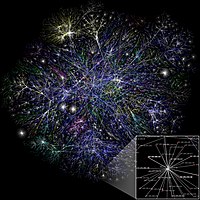
Photo from wikipedia
The mapping of the physical interactions between biochemical entities enables quantitative analysis of dynamic biological living systems. While developing a precise dynamical model on biological entity interaction is still challenging… Click to show full abstract
The mapping of the physical interactions between biochemical entities enables quantitative analysis of dynamic biological living systems. While developing a precise dynamical model on biological entity interaction is still challenging due to the limitation of kinetic parameter detection of the underlying biological system. This challenge promotes the needs of topology-based models to predict biochemical perturbation patterns. Pure topology-based model, however, is limited on the scale and heterogeneity of biological networks. Here we propose a learning based model that adopts graph convolutional networks to learn the implicit perturbation pattern factors and thus enhance the perturbation pattern prediction on the basic topology model. Our experimental studies on 87 biological models show an average of 73% accuracy on perturbation pattern prediction and outperforms the best topology-based model by 7%, indicating that the graph-driven neural network model is robust and beneficial for accurate prediction of the perturbation spread modeling and giving an inspiration of the implementation of the deep neural networks on biological network modeling.
Journal Title: Scientific Reports
Year Published: 2019
Link to full text (if available)
Share on Social Media: Sign Up to like & get
recommendations!